Without limits: developing the social and economic potential of accessible tourism for Queensland
The third Robert Jones Memorial Oration was held on Thursday 9 February 2017 at Royal on the Park, Brisbane.
Professor Simon Darcy, University of Technology Sydney, Business School — Management Group, and the Centre for Business and Social Innovation, delivered the oration titled
Without limits: developing the social and economic potential of accessible tourism for Queensland .
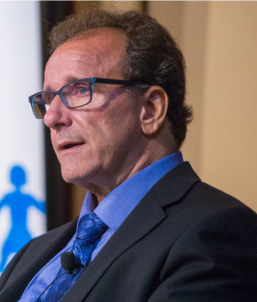 |
| Prof Simon Darcy presenting the Robert Jones Oration |
Contact details for Professor Darcy
Print-friendly versions:
2017 Robert Jones Oration
Robert Jones' life was a testament to the contribution that people with disability can make at the highest level. Kevin Cocks has outlined Robert's life, contributions, and his unwavering principles to ensuring disability citizenship of the highest order. Due to the tight timeframe of the oration (20 minutes) I will not go back over Robert's contribution and allow Kevin's excellent overview stand as testament to his life.
I would like to thank Willie Prince for the Welcome to Country on behalf of the traditional owners, the Yaggera and Turrbal peoples. What I did not know before tonight was Willie's lived experience of disability, his personal involvement with Robert Jones and their shared lives from institutionalisation to active citizenship through community living. Willie and Robert lived through the very worst of what disability institutionalisation could provide through to the many layers of community living from the 1970s–2000s. Thank you Willie for sharing your and Robert's story.
I would like to pay respect to the previous 2 presenters of the Robert Jones oration and the topics that they covered:
- 2015 Robert Jones Oration: Mr.Maha Sinnathamby on visitability
- 2014 inaugural Robert Jones Oration: Dr Margaret Ward on public interest in the design of private housing
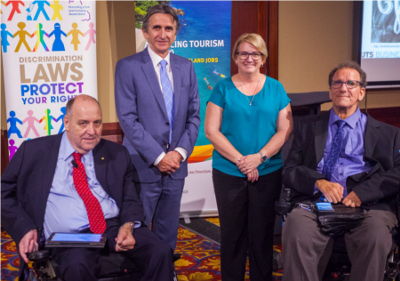
Robert Jones Oration dignitaries: Kevin Cocks AM; Daniel Gschwind, Chief Executive Qld Tourism; Hon. Coralee O'Rourke, Minister for Disability Services; and Professor Simon Darcy
I would also like to acknowledge the Hon Coralee O'Rourke, Minister for Disability Services, Minister for Seniors, and Minister Assisting the Premier on North Queensland, the Hon Kate Jones MP Minister for Education Minister for Tourism and Major Events and the Palaszczuk government's commitment to growing the tourism industry and recognising the importance of accessible and inclusive tourism.
While government is important, as we will learn nothing can be done without the industry and I welcome Daniel Gschwind, Chief Executive Queensland Tourism Industry Council as part of a collaborative approach essential to the success of any tourism strategy.
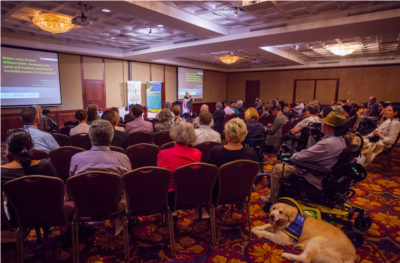
The audience at the 2017 Robert Jones Oration was attentive.
Lastly, it is an absolutely fantastic turnout here tonight with other members of the tourism industry, consumers with disability, disability advocates, the not-for-profit sector, different levels of government and others interested to improve the position of accessible and inclusive tourism as we move towards the full rollout of the
National Disability Insurance Scheme 
(NDIS). For those in the room unaware of the
NDIS , it provides a tremendous game changer for people with disability who will have individualised funding packages and choice and control over where to purchase disability services including leisure, recreation and tourism.
The overview of the oration will cover:
- the United Nations World Tourism Organisation (UNWTO) and other research that identifies the economic and social benefits of accessible tourism
- the UN Convention on the rights of Persons with disabilities
- universal design as it is identified in the first 2 points
- the travel chain
- the importance of developing an access/inclusive culture through management and emphatic process.
I am breaking with the tradition of an oration and presenting a 2 minute video that was developed by the
UNWTO for the
2016 World Accessible Tourism for All Day 
held on 27th of September . The video provides an excellent example of presenting the underlying human rights philosophy, market arguments and social benefits that have been supported with a substantial set of research resources and manuals produced in 2015 by the UNWTO for the industry
[1–6]. I will then supplement this video with other more contemporary research figures undertaken by myself and colleagues from around the academic and market research world.
Well we can all see why I played that video and when you examine the mission statement of the
UNWTO it clearly states that it is the
United Nations' agency responsible for the promotion of responsible, sustainable and universally accessible tourism
[7] First and foremost, by 2050 there will be some 1.5
bn people with disabilities living in the world with increasing levels of quality of life and disposable income. Yet, this is only the starting point of those who benefit from accessible tourism. As identified in Australia the beneficiaries include people with disability as shown in Figure 1, including those who have a temporary disability through injury or illness, families with young children, seniors with access needs and through universal design the creation of safer working environments
[8]. The safer working environments' argument stems directly from universal design creating environments that do not require the lifting of equipment and have better ergonomics for the ongoing health of the workforce. This research suggests that at any time 31% of the population may benefit from these inclusions.

Figure 1: beneficiaries of accessible and inclusive tourism
While the oration does not leave a great deal of time to discuss the very important considerations of the major types of disability or accessibility requirements, it goes without saying that all my comments tonight are inclusive of those with mobility, vision, hearing, cognitive and other access requirements. As we see the rollout of the
NDIS , we are seeing a fulfillment of unmet need particularly across those with cognitive or intellectual impairments and those children on the autistic spectrum who require early intervention in order to live full lives into adult hood
[9]. Creating accessible and inclusive tourism opportunities for these disability groups requires radically different solutions for what could be considered multiple market opportunities. Where many talk of a disability market segment, I talk about the multiple opportunities to develop accessible tourism products and services. Further on traditional market segmentation theory, I strongly argued to the industry that disability is already part of every market segment even though it is not widely recognised
[10, 11].
When we examine the
World Report on Disability [12] and examine market potential of the group within our major domestic and overseas tourism markets then the importance becomes far more pressing with respect to improving our economic position for GDP in attracting tourists internationally. From a domestic position if we consider the approximately 5
m people with disability in Australia and New Zealand (our major international market and our most eastern state!) the numbers are significant in themselves. However, when we examine some of our key markets such as China with 83
m , Japan with 14
mand India with 49
m people with disability we already know the importance of these markets to Australian tourism
[13]. When this is put in context to the EU 27 countries 127
m , US 60
m , Great Britain 10
m and Canada 4
m people with disability this provides significant opportunity to leverage on well established markets, marketing and distribution. However, what people forget is that individuals with disabilities do not travel by themselves and when travelling on a day trip travel with approximately 2–4 people in their group or on overnight stays with 3–5 people in their group
[14–17]. Of course, these numbers of people with disability have been translated into the economic worth of the group with the EU 27 can being valued at €141
bn , the US$17.3
bn and in Australia some 11% of Tourism
GDP directly attributable to
PWD and their group. Yet this figure is nowhere near the 20% of the population identified as having a disability and suggests a potential to improve market and destination development
[14].
The Australian travel rates that I will now present suggest that there are a series of barriers and constraints that affect the travel participation of people with disabilities from daytrips, overnight trips and outbound travel. As shown in Figure 2, while people with disability and the nondisabled undertake day trips at about the same rate, there is a 21% drop in participation by people with disability in undertaking overnight travel and some 51% drop in participation in travelling overseas
[18, 19]. Yet, why is there this decreasing level of participation when travelling overnight or abroad? Mainstream tourism research already shows the tremendous social benefits that come from experiencing tourism, the cultural enrichment, feelings of improve quality of life and decreasing levels of stress. A number of studies have shown that for people with disabilities these experiences and the constraints they face are radically different to that of the nondisabled
[20, 21].

Figure 2: comparative travel rates between people with disability
While I have already presented beneficiaries, economic and social arguments for accessible tourism, it would not be a Robert Jones oration without a conscious link back to human rights. While the Queensland Anti-Discrimination Commission is sponsoring tonight, Australia is also signatory to the
UN Convention on the Rights of Persons with Disabilities such that we should hold the Australian governments to account in understanding our desire for active citizenship within our local areas, regional interchanges, national and international travel. The Convention outlines 8 principles: respect for inherent dignity; nondiscrimination; full and effective participation; acceptance of difference/diversity; equality of opportunity; general accessibility; gender difference; and the importance of the rights of children with disability [22]. Further, in a transport, travel and tourism sense the importance of the following articles of the Convention for people with mobility, vision, hearing, cognitive and other access requirements are paramount to ensuring our right to transport, travel and tourism:
- article 20 personal mobility - where individuals may require personal support or other assistive technology to assist their independent, dignified and equitable wayfinding. Opportunities are emerging for innovative tourism products and services to assist those with personal mobility barriers to reach even the most pristine or cultural sensitive environments e.g. TrailRider
 ;
;
- article 9 that incorporates accessibility in its broadest sense across the built environment, common domain, transport, ICT, and geographic equity in urban and rural areas;
- article 27 work and employment, which has been a focus of governments in breaking the poverty cycle for people with disability and reducing welfarism. Yet this cannot occur unless all the other requisites are in place to create a more enabling environment for people with disability to engage in work and employment with the same ease as the nondisabled;
- article 30 specifically identifies the importance of a
cultural life
including the arts, sport, recreation and tourism. Do we live to work or do we work to live? Whether a person is employed or not there needs to be an inherent respect for their right to a life that is inclusive and enriching of what it means to be a citizen and in our case an Australian.
With respect to transport and travel even with the Disability Standard for Accessible Public Transport we have seen transport as a battleground for key human rights cases including but not limited to:
Without the same rights to transport we are unable to enjoy the same mobility as other people for business or leisure locally, regionally, nationally or internationally. Of course, we could not discuss discrimination in the built environment without acknowledging
Kevin Cocks v State of Queensland. For those people with disability who are frustrated with information planning, transport, accommodation and attractions sectors, we are lucky enough to have an active Australian
Disability Discrimination Act 1992 to undertake complaint cases and Federal Court 
actions. Further each state has a body similar to the Queensland Anti-Discrimination Commission and I am sure that Kevin Cocks is only too ready and willing to assist you to improve the accessibility of your local community or tourism products and services.
With this fleeting examination of these 4 critical articles, there are a significant number of challenges facing not just Queensland but Australia when it comes to some contemporary manifestations of innovative disruption. I would like to mention 3 as I know it is critical within a transport, travel and tourism context but more importantly it is at a time where these issues are being debated by the government, transport and tourism industries.
- Uber and the disruption of point to point traditional taxi services
 . What seems to have been lost in the argument is the hard fought for rights of people with disability like myself who are reliant on paratransit systems. The right to paratransit systems was fought long and hard in each state of Australia and have provided those with mobility, vision and cognitive disabilities who are unable to use public transport or transport themselves to have a viable alternative. Uber and other share economy offerings seek to deregulate what were classic areas of
. What seems to have been lost in the argument is the hard fought for rights of people with disability like myself who are reliant on paratransit systems. The right to paratransit systems was fought long and hard in each state of Australia and have provided those with mobility, vision and cognitive disabilities who are unable to use public transport or transport themselves to have a viable alternative. Uber and other share economy offerings seek to deregulate what were classic areas of market failure
. In other words, regulation was required to ensure that for reasons of equity people with disability have the same rights as other public transport users. Uber does not invest in rolling stock, moves its profits offshore and we are rushing to deregulate a billion-dollar industry without thoughts for the long-term consequences to those who regulation was originally put in place to ensure a more level playing field.
- Similarly with Airbnb
 and other share economy offerings in the accommodation sector — where are the platforms for inclusion of accessible rooms?
and other share economy offerings in the accommodation sector — where are the platforms for inclusion of accessible rooms?
- Without wanting to get into the technicality of the accommodation sector, Queensland has another issue that is worth mentioning. Much of the supply of commercial accommodation currently occurs as serviced apartments which, as Class 2 buildings under the Australian building code, do not require visitability, accessible or adaptable room supply. As a state that wishes to position itself as accessible and inclusive how can you not provide the same opportunities to almost 20% of the population?
- While these last 2 points about the accommodation sector have been on the scene now for over a decade and there has been excellent initiatives by individual operators and chains, there has been a lack of a systematic approach to the accommodation sector's information collation, presentation, promotion, marketing and distribution of accessible rooms stock. Additionally we have seen a multitude of Australian human rights complaint cases highlighting the lack of understanding between suppliers and consumers as to what constitutes room accessibility [23]. Surely we can improve communication and coordination of marketing and promotion of accessible accommodation to provide opportunities for consumers to make a more informed decision about accessible accommodation for their needs and to assist accommodation suppliers and improving occupancy and yield of their accessible rooms stock [18]? Current accommodation marketing, promotion and distribution in Spain and the UK present valuable examples where accessible accommodation stock is used as a mechanism to gain a competitive advantage [1–6].
While we have identified a series of barriers to participation how do we create enabling environments based on the
UNidentified universal design principles? A starting point I would like to bring together the 3 concepts and their definitions - accessible tourism, universal design as outlined by the
UNWTO and the travel chain. First, universal design and accessible tourism which has been defined as:
Accessible tourism is a form of tourism that involves collaborative processes between stakeholders that enables people with access requirements, including mobility, vision, hearing and cognitive dimensions of access, to function independently and with equity and dignity through the delivery of universally designed tourism products, services and environments. This definition adopts a whole of life approach where people through their lifespan benefit from accessible tourism provision. These include people with permanent and temporary disabilities, seniors, obese, families with young children and those working in safer and more socially sustainably designed environments.
(Darcy & Buhalis 2011, p10-11)
[10].
What this definition does is to bring together a great deal of what we have already been speaking about with respect to the inclusion of different disability types, the importance of independence, equity and dignity, and the connection with seniors and people over their lifespan. What becomes important with this definition is seen tonight in the Robert Jones oration room where all the different stakeholders required for accessible tourism to occur in a collaborative process are present, eager to engage in conversations with each other to get a more successful outcome for Queensland. As noted in the academic literature, if your business does not identify tourists as a market and you do not collaborate with other businesses to assist with information and marketing to target tourists then you are not in the tourism business
[24].
Even when these collaborative processes are in place, tourism relies on other sectors to provide aspects of the infrastructure, transport, attractions, regulation, coordination and experience creation. Even before destinations have a clear identity or their
sense of place
[25], their destination competitiveness, sustainability and opportunities for accessible tourism, they must be in a position to have people of different disabilities be able to seamlessly get to and from the destination. The United Nations and the World Bank refer to this as the
the travel chain
and it is not dissimilar to the concept of a
continuous pathway
that underpins the
Disability Standards for Access to Premises 
. The travel chain is a seductively simple concept that is so central to the way people with different abilities need to think about how they are going to travel from point A to point B in undertaking any journey to ensure their mobility locally, regionally, nationally and internationally. The travel chain has been defined as:
refers to all elements that make up a journey, from starting point to destination — including the pedestrian access, the vehicles, and the transfer points. If any link is inaccessible, the entire trip becomes difficult
[12].
While this may seem daunting for a precinct, suburb, city, state or nation, the building blocks can be found in any local community that is regarded as accessible and inclusive. Whether that is so that people with any ability can live, work and have the recreational experiences they want or whether it is areas to visit for business or for holidays. A starting point for any precinct, suburb or city is to create liveable communities where residents are valued and included. Good local accessible communities form the basis for accessible tourism destinations. Whether that be the work done on improving the footpath and pedestrian areas of Noosa or the transport linkages to get people to the World Heritage areas of Cairns.
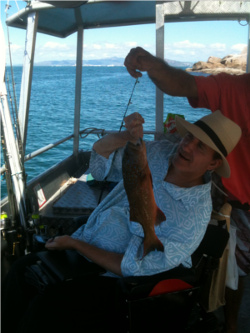
Figure 3: Simon catches a coral trout
As already identified in the oration the information and planning issues become more complicated with overnight travel or with international travel. Travel planning information, bookings, transport linkages, accommodation and tourist attractions are all important elements that make up the journey. Of course, in a tourism sense this is expanded to include multiple transport modes and accommodation for travel involving multiple destinations.
Yet, the linkages that make up the connections to and from a destination are not the reason people travel for tourism purposes. As one person said in research I was carrying out
I just wanted to do cool things without the hassle
and this quote sums up the frustration some people with disability have who feel that they are abandoned by the industry when it comes to providing the information they need on which to make an informed decision to book a trip for the accessible experiences that they want to immerse themselves in. Whether that is going to Sea World on the Gold Coast, going to one of the great outdoor events at Southbank in Brisbane or getting to the
Gold Coast Commonwealth Games in 2018 
. In my own case it was some 20 linkages to the travel chain that was required back in 2012 when I was on a business trip but had always wanted to fish off Magnetic Island. With a bit of a luck everything came together and as Figure 3 shows I caught (and released) a coral trout from a great accessible boat with a real character of a local guide, Cliffy. However, if the tourism industry, government and non-for profit sector have a strategic approach to accessible tourism marketing, promotion and distribution then it should require less luck to have these great experiences.
So to conclude tonight I would like to go back to the definition of accessible tourism and implore those in the room from the commercial tourism sector, government and non-for profits to work together to improve the opportunities for everybody to visit your great state. This is everybody's job to identify a series of tourism products and services that are accessible for the beneficiaries of accessible and inclusive environments including people with mobility, vision, hearing, cognitive, other disabilities, and seniors with access needs. There is great product out there already but it needs to be identified, collated, promoted, marketed and distributed to people with disability. With the NDIS we are at a watershed both from a social policy but also a market perspective where those in industry must recognise the commercial opportunities that are literally just around the corner as the
NDIS rolls out in Queensland in 2018. I am sure that these efforts will bring mutually beneficial outcomes with the tourism industry having improved economic outcomes and consumers enjoying more satisfying tourism experiences. Tonight should be a beginning to addressing one of the largest barriers facing people with disability by changing attitudes of those in industry and government to consider them as a just another group looking to have great (accessible) tourism experiences.
I am sure that Robert Jones would agree that it would be great for the Queensland tourism industry to have a simple slogan Everyone Welcome
(Figure 4).
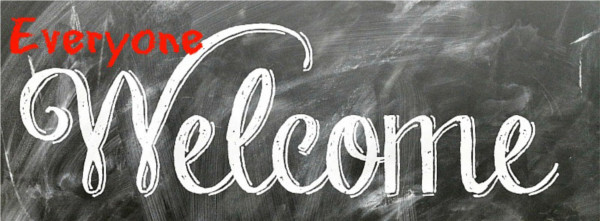
Figure 4: Everyone welcome
Endnotes
1. UNWTO, Manual on Accessible Tourism for All: Public-private Partnerships and Good Practices . 2015, World Tourism Organization (UNWTO) and Fundación ACS: Madrid.
2. UNWTO, Manual on Accessible Tourism for All: Principles, Tools and Good Practices - Module 1 . 2015, World Tourism Organization (UNWTO) and Fundación ACS: Madrid.
3. UNWTO, Manual on Accessible Tourism for All: Principles, Tools and Good Practices - Module 2 . 2015, World Tourism Organization (UNWTO) and Fundación ACS: Madrid.
4. UNWTO, Manual on Accessible Tourism for All: Principles, Tools and Good Practices - Module 3 . 2015, World Tourism Organization (UNWTO) and Fundación ACS: Madrid.
5. UNWTO, Manual on Accessible Tourism for All: Principles, Tools and Good Practices - Module 4 . 2015, World Tourism Organization (UNWTO) and Fundación ACS: Madrid.
6. UNWTO, Manual on Accessible Tourism for All: Principles, Tools and Good Practices - Module 5 . 2015, World Tourism Organization (UNWTO) and Fundación ACS: Madrid.
7. UNWTO, About us . 2016, World Tourism Organization: Madrid.
8. Darcy, S. and T. Dickson, A Whole-of-Life Approach to Tourism: The Case for Accessible Tourism Experiences. Journal of Hospitality and Tourism Management, 2009. 16 (1): p. 32-44.
9. National Disability Insurance Scheme, Annual Report 2015-2016 . 2016, National Disability Insurance Scheme: Canberra and Geelong.
10. Buhalis, D. and S. Darcy, eds. Accessible Tourism: Concepts and Issues . 2011, Channel View Publications: Bristol, UK. 350.
11. Buhalis, D., S. Darcy, and I. Ambrose, eds. Best Practice in Accessible Tourism: Inclusion, Disability, Ageing Population and Tourism . 2012, Channel View Publications: Bristol, UK. 350.
14. Dwyer, L. and S. Darcy, Chapter 14 - Economic Contribution of Tourists with Disabilities: An Australian Approach and Methodology , in Accessible Tourism: Concepts and Issues , D. Buhalis and S. Darcy, Editors. 2011, Channel View Publications: Bristol, UK. p. 213-239.
15. GFK, et al., Economic Impact and Travel Patterns of Accessible Tourism . 2015, European Commission in conjunction with GFK - University of Surrey - Neumann Consulting - Pro A Solutions.
16. Open Doors Organization, Research among Adults with Disabilities: Travel and Hospitality (USA) . 2015, Open Doors Organization: Chicago.
17. Domínguez, T., J.A. Fraiz, and E. Alén, Economic profitability of accessible tourism for the tourism sector in Spain.Tourism Economics, 2013. 19 (6): p. 1385-1399.
18. Darcy, S., Inherent complexity: Disability, accessible tourism and accommodation information preferences. Tourism Management, 2010. 31 (6): p. 816-826.
19. Domínguez, T., S. Darcy, and E. Alén, Competing for the disability tourism market - a comparative exploration of the factors of accessible tourism competitiveness in Spain and Australia. Tourism Management, 2015. 47 (1): p. 261-272.
20 . Burnett, J.J. and H. Bender-Baker, Assessing the travel-related behaviors of the mobility-disabled consumer. Journal of Travel Research, 2001. 40 (1): p. 4-11.
21. Daniels, M.J., E.B. Drogin Rodgers, and B.P. Wiggins, "Travel Tales": an interpretive analysis of constraints and negotiations to pleasure travel as experienced by persons with physical disabilities. Tourism Management, 2005. 26 (6): p. 919-930.
23. Darcy, S. and T. Taylor, Disability citizenship: An Australian human rights analysis of the cultural industries. Leisure Studies, 2009. 28 (4): p. 419-441.
24. Leiper, N., et al., Partial Industrialisation in Tourism: A New Model. Current Issues in Tourism, 2008. 11 (3): p. 207-235.
25. Derrett, R.O.S., Making Sense of How Festivals Demonstrate a Community's Sense of Place. Event Management, 2003. 8 (1): p. 49-58.
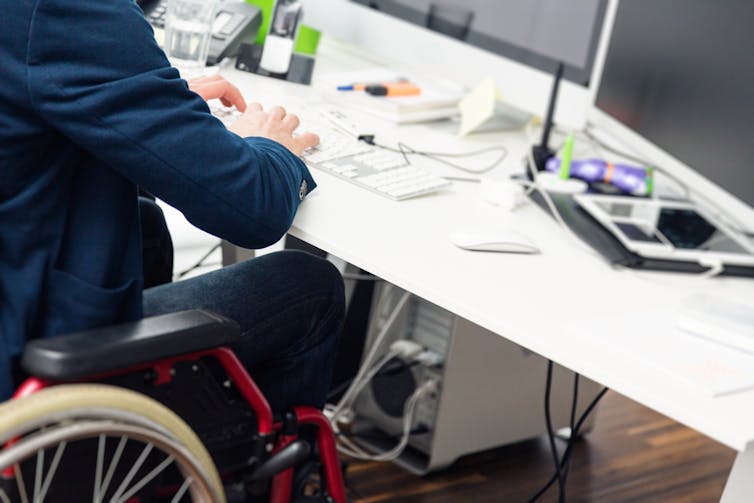
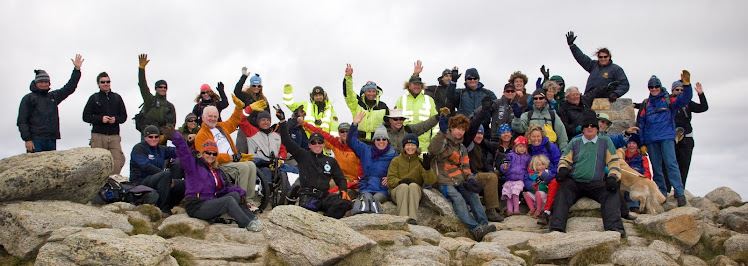





 (NDIS). For those in the room unaware of the NDIS , it provides a tremendous game changer for people with disability who will have individualised funding packages and choice and control over where to purchase disability services including leisure, recreation and tourism.
(NDIS). For those in the room unaware of the NDIS , it provides a tremendous game changer for people with disability who will have individualised funding packages and choice and control over where to purchase disability services including leisure, recreation and tourism.







 3.Manual on Accessible Tourism for All: Principles, Tools and Good Practices, Module III
3.Manual on Accessible Tourism for All: Principles, Tools and Good Practices, Module III 4.Manual on Accessible Tourism for All: Principles, Tools and Good Practices, Module IV
4.Manual on Accessible Tourism for All: Principles, Tools and Good Practices, Module IV 5.Manual on Accessible Tourism for All: Principles, Tools and Good Practices Module V
5.Manual on Accessible Tourism for All: Principles, Tools and Good Practices Module V 







